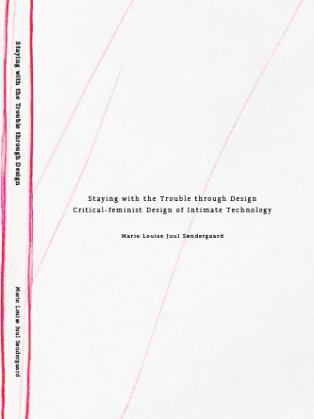Staying with the Trouble through Design: Critical-feminist Design of Intimate Technology
Nøgleord:
Interaction design, intimacy, intimate technology, trouble, taboo, gender, speculative design, design fiction, feminist HCI, women's healthSynopsis
This dissertation explores staying with the trouble through design as a design theory of intimacy and intimate technology. To research and design with the subject of intimacy is to trouble and to ask for trouble, and by staying with the trouble of intimacy, to paraphrase Donna Haraway, I articulate and perform a way of designing not as a way out of trouble, but as a way of making trouble and staying with the trouble. I argue that by staying with the trouble, designers may learn to be “truly present” and respond to social, cultural and political issues of intimate technology.
The methodology interweaves design research, feminist technoscience, critical theory and software studies into a critical-feminist design methodology. As a response to design and designing intimate technology I have engaged in Donna Haraway’s “Staying with the Trouble” (Donna J. Haraway 2016) and solutionism as a critique of technology development, as well as feminist theories on fantasies of “the good life” and gender and technology, and critical theories on the role of intimacy in digital culture.
Within the field of interaction design research, this dissertation’s contribution can be divided into three parts: 1) an exploration of the role of intimate technologies in our everyday lives and ways of being, 2) a critical and feminist design methodology of staying with the trouble through design, and 3) design proposals that stay with the trouble of designing with intimacy.
My design research has evolved through four design projects that interweave different intimate topics and technologies through varied design practices: 1. PeriodShare: an internet-connected menstrual cup. 2. Marcelle: a wearable sex toy reacting on wifi-activity. 3. Ingrid: a woman living with electromagnetic hypersensitivity. And 4. Intimate Futures: two digital personal assistants where one is pushing back on sexual harassment and the other is assisting with hormone level tracking.
The main contribution of the dissertation is the design methodology staying with the trouble through design, which is an anti-solutionist approach to design that interweaves the situated, personal and political role of design. By responding to/with trouble, rather than designing solutions to problems, staying with the trouble through design aims to better understand the conflicts and responsibilities involved in complex social, cultural and political issues, in order to imagine and design still possible futures. The design methodology interweaves three practices that unfold the self-reflective, ethnographic and collaborative process of staying with the trouble through design. The first practice, the willful practice of Staying with the Wrong, is a continuous process of becoming a feminist designer and it includes actively learning to be present; question the given as given, stay with the feelings you wish would go away, continuously practice self-reflection on own positionality and using feminist humour when designing with taboos. The second practice, Curious Visiting, encourages the designer to go beyond their own positionality, by listening to stories of pleasure and pain and visiting ongoing pasts and alternatives nows. This challenges the designer’s notion of the present by interweaving fact and fiction, and it highlights that this practice is never innocent but involves risks. Lastly, the third practice Collective Imagining highlights how design by proposing future change can respond to and/or with trouble and how we collectively can engage with futures to rewrite collective imaginings and tell other possible stories within and across social and cultural contexts. Together, these three interwoven practices propose a way of staying with the trouble through design, as a feminist contribution to current critical approaches within interaction design.

